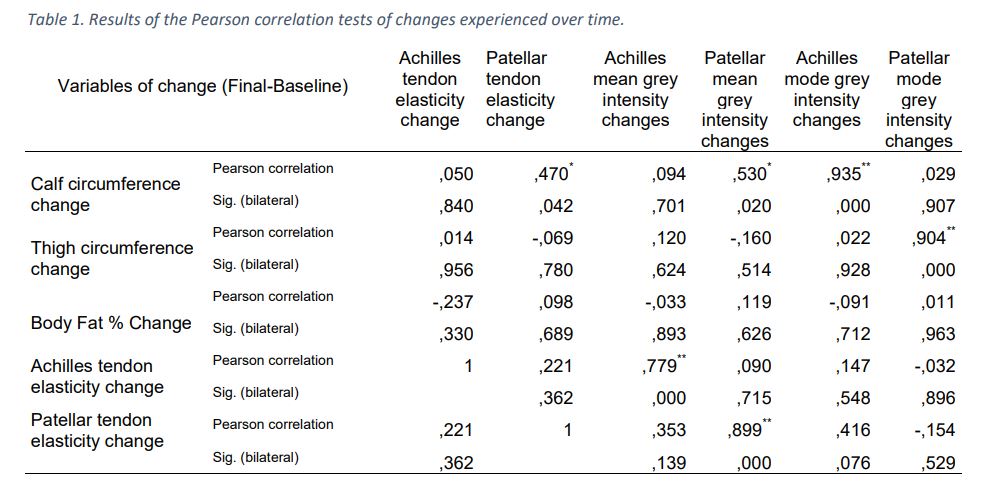Back
Poster Session C
Imaging
Session: (1228–1266) Imaging of Rheumatic Diseases Poster
1250: Physiologic Adaptive Change of the Patellar and Achilles Tendons: Sensitivity to Change Detected by Computer Analysis of Sequential Static Images
Sunday, November 13, 2022
1:00 PM – 3:00 PM Eastern Time
Location: Virtual Poster Hall
- �A
África Andreu Suárez, MMSc
Hospital Universitario Ramón y Cajal
Madrid, Spain
Abstract Poster Presenter(s)
CARLOS ANTONIO GUILLEN ASTETE, Africa Andreu Suarez and Marina Tortosa Cabanas, Ramon y Cajal University Hospital, Madrid, Spain
Background/Purpose: Ultrasound studies stratify the results of the evaluations in ordinal degrees of intensity of findings dependent on the evaluator's opinion. Computer analysis of static images has recently been introduced in the study of patients with rheumatic diseases. Nonetheless, its application in musculoskeletal ultrasound is still very limited. The objective is to determine if this type of image analysis is sensitive to structural adaptive change of the patellar and Achilles tendons in healthy subjects.
Methods: We recruited young volunteers with a declared sedentary habit who carried out a physical exercise routine for 6 months. Two ultrasound measurements of the patellar and the Achilles long axis were performed (as shown in Figure 1). Also, two elastographies of the same tendons and two anthropometric measurements of the thigh and calf were made at the beginning and end of the training period. Computer analysis of the images was performed by three blind observers using the ImageJ 1.53e program. To demonstrate sensitivity to change, a correlation was made between the ultrasound, elastrographic and anthropometric morphological changes, and the result of the computer analysis of the image in terms of gray scale mean and mode.
Results: 19 volunteers were evaluated (mean age 24 ±2 years, 12 women). After the exercise routine, we found statistically significant differences between calf perimeter (mean -3,70 ±1,803; p .000), Achilles elastography (-,347 ±,294; p .000), Achilles and patellar MGI (4,229 ±4,849; p .001 and 2,331 ±3,115; p ,004). Regarding the non-normal distributed variables, we met statistically significant differences between patellar elastography (average range 11,45, sum of the ranks 126,00; Z -2,343; p ,019), Achilles and patellar grey intensity modes (average 12,92, sum 168,00; Z -2,938; p ,003 and average 11,77, sum 176,50; Z -3,28; p ,001). The correlations study is shown in Table 1.
Conclusion: Computer analysis of static images of the Achilles and patellar tendons is sensitive to the change induced by exercise in young and healthy subjects. The mean gray intensity correlates better with elastography. This shows that the predominance of the fibrillar pattern induced by exercise produces a higher speed of sound conduction. The gray intensity mode correlates better with the anthropometric changes experienced by the subjects. The concentration of shades in white extremes translates into greater anthropometric changes. This demonstrates that the stiffness or elasticity of a tendon correlates with the global distribution of gray. The response to mechanical stimuli correlates with the concentration of more intense white tones that are not necessarily scattered (endophytes or pre-enthesophytes).
.jpg)

Disclosures: C. GUILLEN ASTETE, Novartis, Janssen; A. Andreu Suarez, None; M. Tortosa Cabanas, UCB.
Background/Purpose: Ultrasound studies stratify the results of the evaluations in ordinal degrees of intensity of findings dependent on the evaluator's opinion. Computer analysis of static images has recently been introduced in the study of patients with rheumatic diseases. Nonetheless, its application in musculoskeletal ultrasound is still very limited. The objective is to determine if this type of image analysis is sensitive to structural adaptive change of the patellar and Achilles tendons in healthy subjects.
Methods: We recruited young volunteers with a declared sedentary habit who carried out a physical exercise routine for 6 months. Two ultrasound measurements of the patellar and the Achilles long axis were performed (as shown in Figure 1). Also, two elastographies of the same tendons and two anthropometric measurements of the thigh and calf were made at the beginning and end of the training period. Computer analysis of the images was performed by three blind observers using the ImageJ 1.53e program. To demonstrate sensitivity to change, a correlation was made between the ultrasound, elastrographic and anthropometric morphological changes, and the result of the computer analysis of the image in terms of gray scale mean and mode.
Results: 19 volunteers were evaluated (mean age 24 ±2 years, 12 women). After the exercise routine, we found statistically significant differences between calf perimeter (mean -3,70 ±1,803; p .000), Achilles elastography (-,347 ±,294; p .000), Achilles and patellar MGI (4,229 ±4,849; p .001 and 2,331 ±3,115; p ,004). Regarding the non-normal distributed variables, we met statistically significant differences between patellar elastography (average range 11,45, sum of the ranks 126,00; Z -2,343; p ,019), Achilles and patellar grey intensity modes (average 12,92, sum 168,00; Z -2,938; p ,003 and average 11,77, sum 176,50; Z -3,28; p ,001). The correlations study is shown in Table 1.
Conclusion: Computer analysis of static images of the Achilles and patellar tendons is sensitive to the change induced by exercise in young and healthy subjects. The mean gray intensity correlates better with elastography. This shows that the predominance of the fibrillar pattern induced by exercise produces a higher speed of sound conduction. The gray intensity mode correlates better with the anthropometric changes experienced by the subjects. The concentration of shades in white extremes translates into greater anthropometric changes. This demonstrates that the stiffness or elasticity of a tendon correlates with the global distribution of gray. The response to mechanical stimuli correlates with the concentration of more intense white tones that are not necessarily scattered (endophytes or pre-enthesophytes).
.jpg)

Disclosures: C. GUILLEN ASTETE, Novartis, Janssen; A. Andreu Suarez, None; M. Tortosa Cabanas, UCB.

